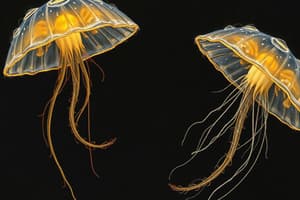Podcast
Questions and Answers
Which class of protozoa is characterized by the presence of flagella?
Which class of protozoa is characterized by the presence of flagella?
- Class Sarcodina
- Class Apicomplexa
- Class Mastigophora (correct)
- Class Ciliophora
What is the main method of survival for protozoa during unfavorable environmental conditions?
What is the main method of survival for protozoa during unfavorable environmental conditions?
- Asexual reproduction
- Replication
- Encystment (correct)
- Migration
Which subgroup of Class Mastigophora consists of plant-like flagellates?
Which subgroup of Class Mastigophora consists of plant-like flagellates?
- Zoomastigophorea
- Ciliates
- Amoeboid protozoa
- Phytomastigophorea (correct)
Which of the following diseases is caused by the Trypanosoma species in humans?
Which of the following diseases is caused by the Trypanosoma species in humans?
What is a characteristic feature of protozoa in the Class Sarcodina?
What is a characteristic feature of protozoa in the Class Sarcodina?
What type of nutrition is most commonly exhibited by protozoa?
What type of nutrition is most commonly exhibited by protozoa?
In what form do many protozoa excrete nitrogenous wastes?
In what form do many protozoa excrete nitrogenous wastes?
Which locomotory organelle is characterized by short hair-like filaments?
Which locomotory organelle is characterized by short hair-like filaments?
What is a common characteristic of the cytoplasm in protozoa?
What is a common characteristic of the cytoplasm in protozoa?
Which of the following statements about reproduction in protozoa is true?
Which of the following statements about reproduction in protozoa is true?
Flashcards
Protozoa characteristics
Protozoa characteristics
Protozoa are unicellular organisms found in moist environments, often as solitary individuals or in colonies. They have various feeding mechanisms, including holozoic (animal-like), holophytic (plant-like), and saprozoic (absorbing).
Protozoan locomotion
Protozoan locomotion
Protozoa move using pseudopodia (temporary extensions of the cytoplasm), flagella (whip-like appendages), cilia (tiny, hair-like appendages), or no appendages at all.
Protozoan nutrition types
Protozoan nutrition types
Protozoa show various nutritional methods: holozoic (eating other organisms), holophytic (making food like plants), and saprozoic (absorbing dissolved nutrients).
Protozoan reproduction
Protozoan reproduction
Signup and view all the flashcards
Protozoan size
Protozoan size
Signup and view all the flashcards
Encystment in Protozoa
Encystment in Protozoa
Signup and view all the flashcards
Class Mastigophora
Class Mastigophora
Signup and view all the flashcards
Trypanosoma
Trypanosoma
Signup and view all the flashcards
Amoeba (Sarcodina)
Amoeba (Sarcodina)
Signup and view all the flashcards
Study Notes
Subkingdom Protozoa
- The phylum Protozoa includes more than 50,000 species found in almost all habitats with moisture.
- Most are very small (unicellular), only visible with a light microscope; some are only 2-3 µm long.
- Many exist as solitary individuals, but some form colonies.
- Some are free-living (freshwater, saltwater, damp places), others are parasitic (endoparasites).
- Most have a single nucleus with nucleoli (endosomes) in the cytoplasm.
- Cytoplasm is divided into clear ectoplasm (outer) and granular endoplasm (inner).
- Some have a rigid pellicle or non-living external envelopes (gelatinous, cellulose, calcareous).
- Locomotion occurs via temporary cytoplasm protrusions (pseudopodia), whip-like filaments (flagella), or short hair-like filaments (cilia). Some lack locomotory organelles.
- Holozoic nutrition is common (active feeding on other organisms or decaying matter). Some species exhibit holophytic nutrition (plant-like, synthesizing organic material from sunlight).
Subkingdom Parazoa
- Sponges are mostly marine, sessile animals with little or no detectable movement.
- They are considered the most primitive multicellular animals and are placed in a separate subkingdom called Parazoa.
- This subkingdom includes the phylum Porifera.
Subkingdom Metazoa
-
Multicellular animals are called Metazoa.
-
Metazoa differ from Protozoa in attaining larger sizes and requiring a specialized digestive system due to increased nutritional needs.
-
Specialized body cavities for digestion are required for larger food particles
-
The larger size necessitates a circulatory system to deliver nourishment and respiratory gases to the tissues, diffusion will not suffice
-
Tissues are more developed and organized into organs which form systems in higher phyla
-
A nervous system allows coordination between cells and tissues, and communication from receptors to effectors
-
Metazoa have developed supportive structures (external/internal skeletal systems) and reproductive organs that produce sexual gametes rather than in cells as in Protozoa
Class Turbellaria
- Free-living flatworms (Platyhelminthes) in freshwater and marine environments.
- Possess a flattened, bilaterally symmetrical body.
- Have a simple digestive system; (Mouth, lacking an anus)
- Excretory system of flame cells
Class Trematoda
- These are parasitic flatworms, which cause fascioliasis in humans.
- They lack a coelom and have complex life cycles, many using intermediate hosts
- The trematodes Fasciola hepatica commonly infect livestock.
Class Cestoda
- These are parasitic ribbon-like flatworms (tapeworms).
- Commonly found in the intestines of vertebrates.
- Their bodies consist of many repeating units called proglottids. Tapeworms lack a digestive system.
Class Nematoda
- These are roundworms with a complete digestive system, with a mouth and anus.
- Most are free-living, some are parasitic (affecting plants and animals).
- Elongate, cylindrical, non-segmented body covered with a cuticle
- Muscles consist of longitudinal fibers
Class Ascaridata
- These are parasitic roundworms living in the intestines of vertebrates
- Oviparous, large and stout nematodes.
- Mouth has 3 prominent lips and a lack of a buccal capsule.
- Males have two copulatory spicules
- The life cycle can be direct or indirect, often involving larval stages
Class Strongylata
- These are parasitic roundworms of vertebrates that lack lips.
- They possess a well-developed buccal capsule with teeth, and males have a copulatory bursa.
- The life cycle usually involves larval stages and may utilize intermediate hosts.
Studying That Suits You
Use AI to generate personalized quizzes and flashcards to suit your learning preferences.




